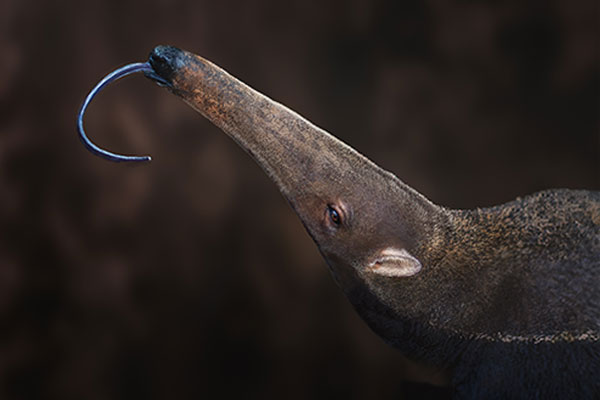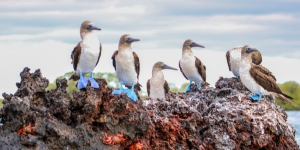If you’ll pardon my stating the obvious, that’s a lot of ants! Given their overwhelming global population, it would be easy to imagine that a great many animals would be ant eaters, in the same way that if I were surrounded by a quadrillion jelly beans, it wouldn’t be long before I started popping them in my mouth at every opportunity.

In spite of this, there are relatively few vertebrate animals that regularly prey on ants. Some frogs and lizards make a habit of it, and a few birds — woodpeckers especially — do too, but among the mammals in particular, ant eating is a rare phenomenon.
There are good reasons to avoid the ant buffet. Ants are very small, of course, so one must consume a lot of them to power a large body. Their colonial habits make that possible, but the largest concentrations of ants are often concealed in nests that are protected underground, in wood, or in other structures, making access a problem.
The situation gets worse, because it turns out that ants don’t take very kindly to being eaten. Their colonies are well-defended by armies of dedicated soldiers which, depending on the species, can bite and/or sting. Anyone who’s accidentally trodden on an ant nest can attest that lunch is seldom the first thought that enters the mind.
It is perhaps unsurprising, then, that ant-eating is so rare. But generally, if there is a potential food source in nature, however unappetizing or inaccessible, somebody will figure out how to eat it. In this case, that somebody is the anteaters.

Top: Giant Anteater, Silky Anteater
Bottom: Northern Tamandua, Southern Tamandua
There are four species of anteaters in the world: the Giant Anteater, Silky Anteater, Northern Tamandua, and Southern Tamandua. All are native to Central and South America. The name ‘anteater’ is sometimes also applied to the Aardvark of Africa, the pangolins of Asia, and the Numbat and echidnas of Australia. Though these pretenders are not closely related to the true anteaters, they have evolved very similar adaptations to a similar lifestyle.
All of these animals specialize on eating ants, though it must be said that most also have a taste for termites. While termites and ants are different groups of insects entirely, they bear some important similarities — small size, colonial lifestyle, nest inhabiting, and enthusiastic self-defense — which mean that an animal adapted to eating one is well-suited to eating the other, too.
Being an effective eater of ants means solving the various challenges ants present, and, for all of the anteaters, that requires three main tools: an elongated snout, a long and sticky tongue, and a hefty set of claws. A long snout is perfect for probing into holes and cavities in search of the anteater’s tiny quarry, which it locates with a keen sense of smell. Once the ants are located, long, hooked claws are the ideal tool for tearing into the soil, a termite mound, dead wood, or other substrates. When the ants or termites rush to defend and repair the breach, the tongue goes to work.

An anteater’s tongue is its most specialized piece of equipment, and the rest of its anatomy is built around it. Its mouth contains no teeth and very little excess space. It opens only wide enough for the tongue to slide in and out, which it does with great speed, well in excess of 100 times per minute. In the Giant Anteater, the tongue is nearly half a metre in length, and in all species, it is covered in tiny hooks and very sticky saliva.
To gather the ants from an opened nest, the anteater flicks its tongue rapidly through the nest’s nooks and crannies. Every time the tongue returns to the mouth, the anteater simultaneously crushes and swallows its cargo. The speed of this operation gives the ants little opportunity to engage their defenses, and anteaters typically spend only a short time at each nest, leaving before the colony can fully mobilize its army.

This extreme lifestyle has its drawbacks, as an anteater may need to visit hundreds of nests per day to fulfil its caloric requirements on ants or termites alone. But this small group of dedicated mammals has made it work, and in the process has become one of the most unusual and fascinating groups of animals on the planet.
The Giant Anteater is perhaps the easiest of the four to see if you’re in the right place for it, as it is the most likely to be active during the day and to frequent open habitats. It is an undeniable highlight for our Brazil travellers when we are fortunate enough to see one. The others are nocturnal forest dwellers, but can be encountered with a little luck in places like Honduras, Costa Rica, and Panama. If you’re considering a trip to the Neotropics, be sure to keep your eyes peeled for the weird and wonderful anteaters!



